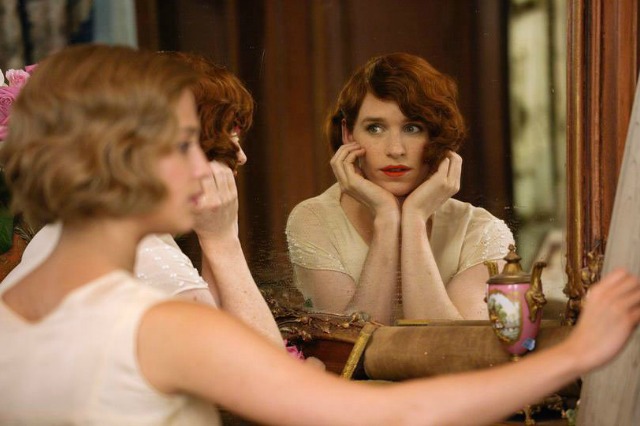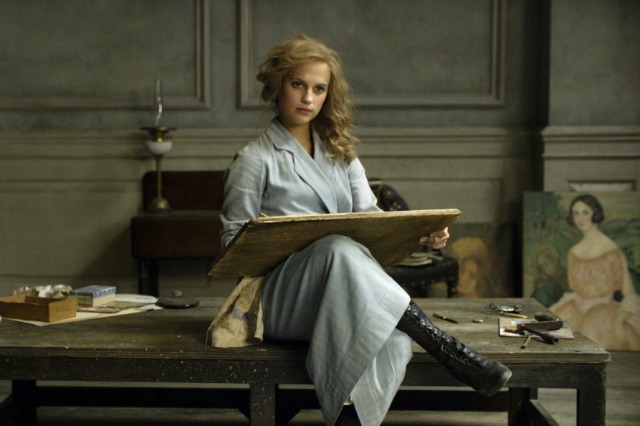'The Danish Girl' Takes A Superficial Look At A Transgender Trailblazer
By Joel Wicklund in Arts & Entertainment on Dec 11, 2015 10:31PM

Alicia Vikander and Eddie Redmayne in "The Danish Girl." (Photo: © 2015 - Focus Features.)
The Danish Girl feels like a missed opportunity. The acting is excellent, the visual style expressive, and it has some genuinely moving scenes. Still, by the end, the honest, difficult story suggested early on has been sacrificed for reassuring and simplistic uplift, tailor-made for awards season.
Based on David Ebershoff's novel, The Danish Girl is a fictionalized account of the true story of Lili Elbe (born Einar Wegener), a successful painter and one of the first people to undergo gender reassignment surgery. Eddie Redmayne plays Lili and Alicia Vikander (Ex Machina) plays her wife, Gerda Gottlieb, also a gifted artist.
At first, the open-minded Gerda considers her partner's cross-dressing to be a fetish, and even works it into their sex life. But it's soon clear that Einar's femininity has a different significance, and their relationship will soon be irrevocably changed.
The Danish Girl is at its best in tumultuous scenes where Lili's emergence wreaks havoc on the seemingly happy marriage. At one point Gerda reminds Lili that more than one person is being affected by her transformation. It's a reminder the filmmakers needed as well, as Gerda's torment is eventually tossed off like excess story baggage.
Instead of the dynamic, conflicted character she begins as, Gerda shrinks to the ultimate "stand by your man" model wife—loving and supporting Lili unconditionally, even as she endures her partner's infidelities and cold, remote responses to her feeling of abandonment.
Another, secondary character gets similarly shortchanged. Playing an art dealer who, as a boy, first prompted Lilli to question her gender identity, Matthias Schoenaerts gets one key scene, where he gets re-introduced to Lili after her transition. It seems like Schoenaerts (so great in movies like Rust and Bone, Bullhead, and The Drop) has another rich part to dig into.
However, Lucinda Coxon's screenplay then removes any conflicted emotions from the role. The childhood pal becomes a stalwart family friend and convenient substitute love interest for Gerda. Schoenaerts delivers the movie's most crowd-pleasing line when he tells Lili, "I like very few people, and you have been two of them," but by then his character has been reduced to a walking panacea.

Alicia Vikander in "The Danish Girl." (Photo: © 2015 - Focus Features.)
The story is set in the '20s and '30s, so society's view of women during that era has to be considered. Even so, for a movie that takes pains to show several characters with a near-contemporary acceptance of sexual ambiguity, little time is spent examining the limitations on women of the time.
For example, Lili stops painting, telling Gerda she wants to focus on being a woman. Gerda responds, "You can do both," but the topic is dropped there. Lili smiles glowingly as she goes from expressing herself on the canvas to demonstrating proper perfume application at an upscale shop.
Even as she faces possible death, the film soothingly shuffles the audience past worries of a life cut short or creativity stifled. We see Lili's contentment as a woman and that, we are to assume, makes everything else trivial. Even the depictions of menace from unenlightened doctors and an act of physical abuse seem like afterthoughts in film too eager to get to the comfort zone.
If all this makes the movie sound distressingly shallow, it does have some admirable qualities worth noting. It's certainly a quantum leap for director Tom Hooper. Coming off the visually uninspired The King's Speech (for which he inexplicably won an Oscar) and the almost amateurishly uneven Les Misérables, I didn't expect the kind of striking yet delicate visual composition Hooper shows here.
As for Redmayne's much-heralded performance, it's very good, but not the best in the film. Redmayne gets to show the extreme physical alteration that Academy Award voters love to reward (as they did last year for his performance in The Theory of Everything), but he can't quite match Vikander's intensity and emotional range as Gerda struggles through confusion, heartbreak, anger and acceptance.
The Danish Girl needed more of what Vikander brings to it: a willingness to fully embrace anguish and uncertainty. The movie's message is basically "be true to yourself," but it dodges the complexities and conflict below that maxim's surface.
The Danish Girl. Directed by Tom Hooper. Screenplay by Lucinda Coxon, based on a novel by David Ebershoff. Starring Eddie Redmayne, Alicia Vikander, Amber Heard, Matthias Schoenaerts and Ben Whishaw. 120 mins. Rated R.
Opens Friday, Dec. 11 at Landmark's Century Centre Cinema and AMC's River East 21 in Chicago, and at Cinemark's Century 12/CineArts 6 in Evanston. Advance showings Thursday, Dec. 10 at AMC's River East 21 and Cinemark's Century 12/CineArts 6.